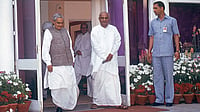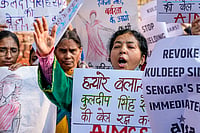Round one went to the public two years ago. The Supreme Court, on April 16, ’04, directed 26 scheduled commercial banks, including the State Bank of India, to pay to a charitable cause"upwards of Rs 3,600 crore" it had collected in excess from five crore borrowers across the country. The banks had "charged extra" over a period of five years and eight months by rounding off interest rates on loans on the higher side by 0.25 per cent. This, the apex court ruled, was illegal.
Given the enormous logistical difficulty in returning the additional interest, the then Chief Justice of India, V.N. Khare, and Justice S.B. Sinha had ruled that the money recovered from the banks be maintained as a corpus fund for the welfare of the disabled. It also fined all the respondent banks
Rs 50 lakh each, and directed that this money too be part of the corpus. It authorised the Comptroller and Auditor General of India to effect the recoveries, and directed that a trust be formed under his chairmanship, with the Union finance and law secretaries as ex-officio members.
But astonishingly, even two years down the line, nothing has been done to implement the apex court’s orders. Forget setting up a trust and a corpus for the disabled, even the first step—recovery of the excess money from the banks—has not been initiated. As a result, the petitioner in the case, the Association of Borrowers of Karnataka, filed a fresh writ petition before the SC last fortnight seeking redressal. Meanwhile, a counter affidavit has been filed to this writ petition in the SC by the under-secretary, Union ministry of social justice and empowerment, arguing that the recovered money be transferred to a national trust set up by the government in 1999 for people suffering from autism, cerebral palsy, mental retardation and multiple disabilities. "...This trust is well equipped to take up such tasks as directed by the court, and no other trust is required to be set up under the 1995 Persons with Disabilities Act," he contends in the affidavit.
K.N. Nagaraju, president of the borrowers’ association, says the apex court’s landmark judgement needs to be lauded. But, as he puts it, "The Karnataka HC had escheated the excess money in favour of the Union government, but the SC said the money should be utilised for the cause of the disabled. Following the judgement, the Helen Keller Foundation had wanted to fete the two judges for their humanity...they politely refused, stating they had only done their duty. If even an SC order does not get implemented in this country, what are we to do as citizens?"
BV. Nagarathna, one of the lawyers who fought the case, finds the government attitude appaling. "The law does
not concern itself with trifles," finance minister P. Chidambaram had contended in the SC then, while arguing as a senior counsel for the State Bank of India in what was an unprecedented case that brought to light the arbitrariness of Indian banks. Luckily, the SC did not consider the excess interest issue a trifle matter. In its verdict, it not only upheld the 1998 judgement of the Karnataka HC, which said the money collected by the rounding off act was illegal, but also passed a progressive order in the realm of affirmative action.
There is no doubt that this case, which deals in the dry parlance of decimal points and fractions, got a human face because of the SC’s specific intervention in favour of the disabled. But its 12-year-long run in the courts is a tribute to a committed and alert citizenry, as well as arguing the case effectively in courts. The case was filed as a pil in the Karnataka HC in 1994 by M/s Devakala Consultancy, a partnership firm engaged in assisting the banking public. It was in December 1998 that the HC asked the banks to refund the excess money. The banks went to the Supreme Court and at this stage Devakala, which did not have the resources to continue at the apex level, passed the case on to the borrowers’ association. Ever since, it has practically been the fight of one individual, K.N. Nagaraju. He meticulously studied voluminousRBI guidelines, annual reports and developed a mathematical model to convince the apex court of how the banks had deliberately erred. "The banks had collected additional sums of Rs 723.79 crore annually, multiply this by 22 quarters and you get a huge figure, upward of Rs 3,600 crore. Then there is the compounded interest due to the delays...it will throw up a mind-boggling figure," he says.
So where and how did the banks slip? By virtue of the Finance Act 1991, the provisions of the Interest Tax Act 1974 were reintroduced. Following this, a three per cent interest tax was imposed on the interest earned by the banks. TheRBIallowed the banks to pass on this burden to consumers with term loans. But the trouble was precipitated when theRBIand the Indian Bank Association, in a communication dated October 9, ’91, advised that the rate of interest be not only loaded with interest tax of three per cent, but also rounded off to the higher 0.25 per cent. This was the catch, found to be illegal by both the HC and the apex court.
Individual borrowers did not even realise that they were being charged above the stipulated and agreed-upon interest, probably because of some misplaced notions of public sector banks being wholly trustworthy. It also lends credence to the maxim that few people scrutinise their accounts with a magnifying glass. The fact remains that people lost money, and though 0.25 per cent seems like a minuscule amount, it works out to be substantial when one considers the numbers involved.
Consider how Nagaraju made out the analogy: "Assume a loan amount of over Rs 50,000 up to Rs 2 lakh, the interest per annum is 16.5 per cent as per theRBIdirective. Excess interest as per illegal rounding off is 0.25 per cent. So, for an amount of Rs 2 lakh the excess interest per quarter is Rs 1,275. If one multiplies this by 22 quarters, after which theRBI withdrew the rounding off, the excess amount collected by the bank from say a farmer, artisan or a small borrower is Rs 28,050. Is this a ‘trifle’ amount that one should let go?" he asks. The devil really is in the details.


























